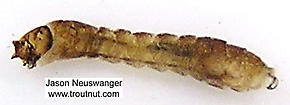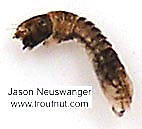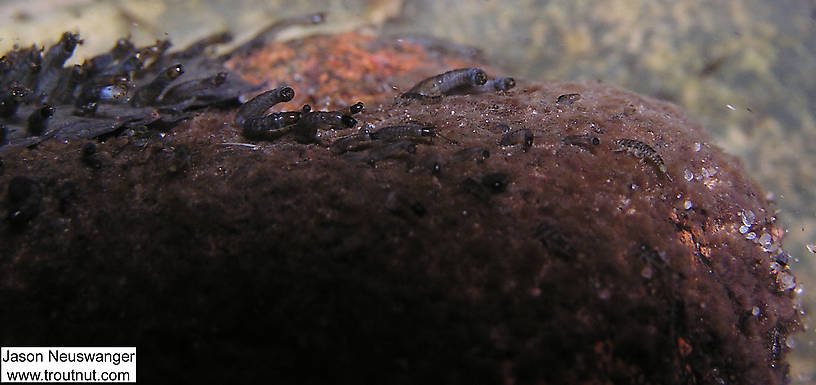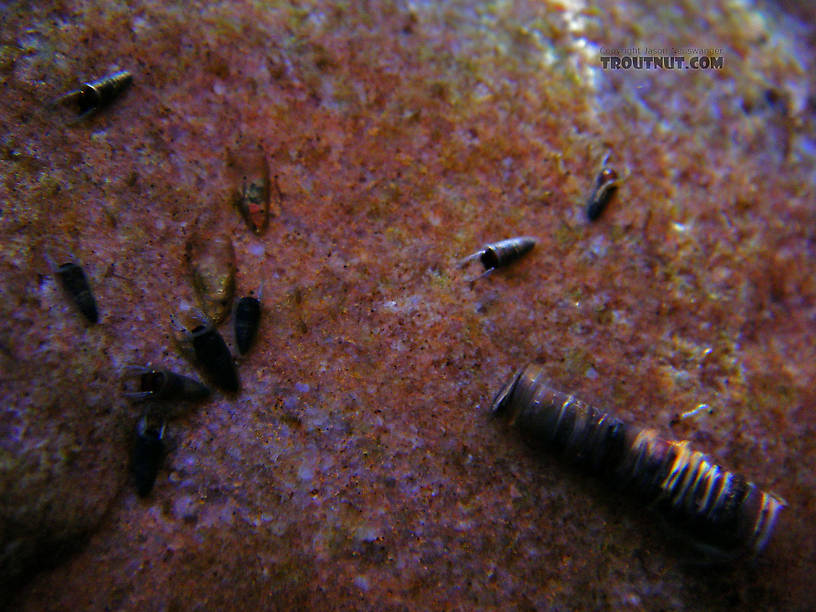Blog & Latest Updates
Fly Fishing Articles
Insects by Common Name


True Fly Family Simuliidae (Black Flies)
Taxonomic Navigation -?-
Kingdom
Animalia (Animals)
» Phylum
Arthropoda (Arthropods)
» Class
Insecta (Insects)
» Order
Diptera (True Flies)
» Family Simuliidae (Black Flies)
12 genera aren't included.
Common Name
| Match | Common Name |
| Black Flies |
The adults are nasty, annoying, biting flies.
Larva & Pupa Biology
Diet: Plankton
Environmental Tolerance: Requires clean, cool, pure water
Black fly larvae live together in colonies, sticking to rocks in riffles and filtering plankton from the waters. Several of them are shown in my underwater photos. These colonies may be found in very very fast water.Environmental Tolerance: Requires clean, cool, pure water
Pictures of 4 Black Fly Specimens:
Simuliidae (Black Flies) Black Fly Larva View 6 Pictures
View 6 Pictures
 View 6 Pictures
View 6 PicturesCollected March 30, 2007 from Fall Creek in New York
Added to Troutnut.com by Troutnut on April 2, 2007
Added to Troutnut.com by Troutnut on April 2, 2007
Simuliidae (Black Flies) Black Fly Larva View 4 Pictures
View 4 Pictures
 View 4 Pictures
View 4 PicturesCollected March 1, 2004 from unknown in Wisconsin
Added to Troutnut.com by Troutnut on January 25, 2006
Added to Troutnut.com by Troutnut on January 25, 2006
Simuliidae (Black Flies) Black Fly Larva View 3 Pictures
View 3 Pictures
 View 3 Pictures
View 3 PicturesCollected February 5, 2004 from Schacte Creek in Wisconsin
Added to Troutnut.com by Troutnut on January 25, 2006
Added to Troutnut.com by Troutnut on January 25, 2006
4 Underwater Pictures of Black Flies:

This is my favorite underwater picture so far. It shows a bunch of Simuliidae (black fly) larvae clinging to a rock and swinging in the fast current. There are also at least four visible mayfly nymphs, probably in the family Baetidae.
In this picture: True Fly Family Simuliidae (Black Flies) and Mayfly Family Baetidae (Blue-Winged Olives).
In this picture: True Fly Family Simuliidae (Black Flies) and Mayfly Family Baetidae (Blue-Winged Olives).
StateWisconsin
LocationEighteenmile Creek
Date TakenMar 19, 2004
Date AddedJan 25, 2006
AuthorTroutnut
CameraOlympus C740UZ

Some large Ephemerella mayfly nymphs cling to a log. In the background, hundreds of Simuliidae black fly larvae swing in large clusters in the current.
In this picture: Mayfly Species Ephemerella subvaria (Hendrickson), True Fly Family Simuliidae (Black Flies), and Mayfly Species Ephemerella invaria (Sulphur Dun).
In this picture: Mayfly Species Ephemerella subvaria (Hendrickson), True Fly Family Simuliidae (Black Flies), and Mayfly Species Ephemerella invaria (Sulphur Dun).
StateWisconsin
LocationNamekagon River
Date TakenMar 20, 2004
Date AddedJan 25, 2006
AuthorTroutnut
CameraOlympus C740UZ

The large caddisfly case (really less than 1/2 inch) is a Brachycentridae larva. The other cases are actually the protective sheaths of black fly (Simuliidae) pupae. The two antler-like pieces sticking out of each one are not legs, but antennal sheaths.
In this picture: Caddisfly Family Brachycentridae (Apple Caddis and Grannoms) and True Fly Family Simuliidae (Black Flies).
In this picture: Caddisfly Family Brachycentridae (Apple Caddis and Grannoms) and True Fly Family Simuliidae (Black Flies).
StateWisconsin
LocationSpring Creek
Date TakenJun 22, 2006
Date AddedJul 1, 2006
AuthorTroutnut
CameraPENTAX Optio WPi
Recent Discussions of Simuliidae
Thank you for the nice quality pictures. 1 Reply »
Thank you for the nice quality pictures. I want to use your picture in my personal presentation in my science class. Would you mind this? I will wait your answer. thank you.
ReplyBlack flies--bane and boon 37 Replies »Although many anglers have been driven from the stream by these nasty little flies, the fish love them. I remember a crazy day on a tiny Pike County brook trout creek. The black flies were legion, but so were the brookies. As long as I could stand it (I was prepared with a headnet, but it was only a partial defense) the little trout hammered a Griffith's Gnat on almost every cast.
Even if you can't tolerate the adult flies, an imitation of the larvae is very good. In fact, Don Holbrook (the author of Midge Magic) recently told me that his imitation of these larvae was the single most reliable and productive pattern of all of his "midge" imitations. He complained (only partly in jest) that the widespread spraying for black flies could ruin his fishing!
-Gonzo
Replytiny flies in my tank filter are reproducing like mad 16 Replies »Even if you can't tolerate the adult flies, an imitation of the larvae is very good. In fact, Don Holbrook (the author of Midge Magic) recently told me that his imitation of these larvae was the single most reliable and productive pattern of all of his "midge" imitations. He complained (only partly in jest) that the widespread spraying for black flies could ruin his fishing!
-Gonzo
I've been looking around the web to find out what they are and I saw a site that said they were drain flies? It makes sense to call them that but what are their true name? It can't be drain flies can it? Anyway they are taking over my tank. They start out like 1cm long white inch worms that have a black tip on the face and tail, they then form a brownish-black shell, like a cocoon and then they turn into tiny flies the size of a gnat or fruit fly and they don't die under water they are water proof. I hate to say it if you guys are bug lovers but they have to move out, possibly to the swampy stream out back. Does anyone know their name and if they are harmful to goldfish at an epidemic rate? They breed like crazy and I can't keep up.
ReplyWest Branch FliesPosted by Jpsully on Sep 15, 2006
Jason:
Very nice site, indeed!
Just wanted to acknowledge your assistance and say thanks for your help in identifying a bug I happened to seine out of the Upper Delaware this week - on a drizzly afternoon, there were tiny BWO's coming off in small numbers; but also present (in greater numbers) was a size 24/26 down-winged light-olive insect, with black mottling, that I had not seen before. They rode the current for quite a while, and the trout were quietly sipping them. After describing the fly (as best I could), you were able to provide photos, along with the suggestion that these were "blackflies" (Simulidae). I had no idea that these flies were present in the Delaware system, but will certainly carry a few imitations from now on (just in case).
JP
ReplyVery nice site, indeed!
Just wanted to acknowledge your assistance and say thanks for your help in identifying a bug I happened to seine out of the Upper Delaware this week - on a drizzly afternoon, there were tiny BWO's coming off in small numbers; but also present (in greater numbers) was a size 24/26 down-winged light-olive insect, with black mottling, that I had not seen before. They rode the current for quite a while, and the trout were quietly sipping them. After describing the fly (as best I could), you were able to provide photos, along with the suggestion that these were "blackflies" (Simulidae). I had no idea that these flies were present in the Delaware system, but will certainly carry a few imitations from now on (just in case).
JP
Your Thoughts On Simuliidae:
Top 10 Fly Hatches
Top Gift Shop Designs
Eat mayflies.
Top Insect Specimens
Miscellaneous Sites
Troutnut.com is copyright © 2004-2024 Jason
Neuswanger (email Jason). See my FAQ for information about use of my images.
 privacy policy
privacy policy
